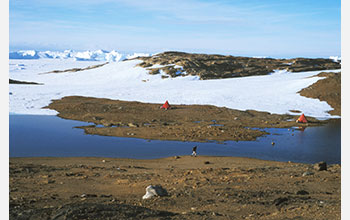

Researchers studying minerals in the Larsemann Hills set up their camp on Stornes Peninsula. This view, taken facing north, was taken after the researchers returned to camp from a traverse. For several days, approach to camp was blocked by rising water from nearby Lake Ferris that necessitated a detour--and moving one tent. The icebergs in the distance remained during the time the team was there, and probably through the entire summer.
In November 2003, Edward S. Grew, a research professor in the School of Earth and Climate Sciences at the University of Maine in Orono, and Christopher J. Carson, a senior Antarctic geoscientist with Geoscience Australia in Canberra, were part of a team of researchers that travelled to Antarctica's Larsemann Hills as part of a study to determine how abundant boron and phosphorus were in the area, and to suggest an explanation for why there might be an exceptional enrichment there. The trip began a decade-long research project that culminated in the 2014 designation of the area as an Antarctic Specially Protected Area (ASPA).
The Larsemann Hills are a 40-square-kilometer region of rocky islands and promontories on the eastern shore of Prydz Bay. Previous studies of the area suggested that boron and phosphorus were there in large quantities, which would be particularly exciting because the two elements are rarely found in more than trace amounts in highly deformed and metamorphosed rocks such as the granulite-facies metamorphic rocks exposed in the Larsemann Hills.
You can read the entire story about this expedition online in Earth magazine, "Protecting the mineral treasures of Antarctica's Larsemann Hills."
Credit: Edward S. Grew, University of Maine . |

Nenhum comentário:
Postar um comentário
Observação: somente um membro deste blog pode postar um comentário.